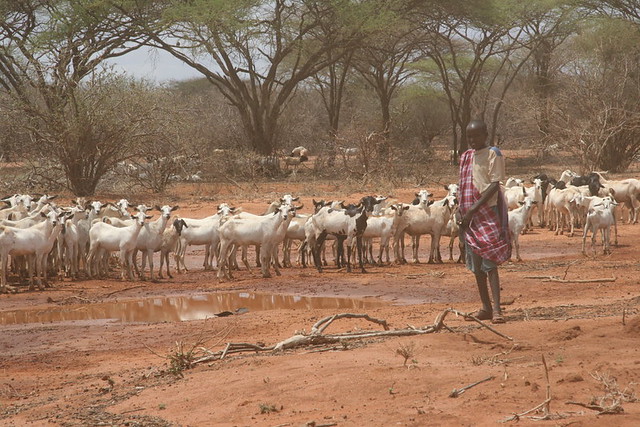A young boy herds a flock of goats on the road to Wajir from Garissa in northeastern Kenya, an area that has experienced outbreaks of Rift Valley fever, which kills both livestock and people (photo by IRIN).
Rift Valley fever occurs in East Africa as explosive outbreaks separated by prolonged periods of 8 to 10 years when the disease disappears. The episodic nature of the disease and the rapid evolution of outbreaks create special challenges for controlling the disease. Following 2006/2007 Rift Valley fever outbreaks in East Africa, decision-makers assembled their collective experiences in the form of a risk-based decision-support tool to help guide responses in future emergencies. Because a series of natural events are indicative of an increasing risk of an outbreak of Rift Valley fever, actions should be matched to this evolving risk profile. The decision-support tool is a living document written through stakeholder input.
At a workshop convened by the Food and Agriculture Organization of the United Nations (FAO) and the International Livestock Research Institute (ILRI) and held at ILRI's headquarters, in Nairobi, Kenya, in late March 2008, participants generated the initial material, which was then compiled and edited into the first draft of the decision-support tool.
The first draft of the decision-support tool was then exposed to critical review by close to 100 participants at the United States Centers for Disease Control's Rift Valley Fever Workshop 2008, 'Scientific pathways toward public health prevention and response,' held in Nairobi in early May 2008. A small group drawn from participants at the initial workshop reviewed the revised document at a meeting held at ILRI in September 2008 and final changes recommended by them have been incorporated into this version.
This decision-support tool has been reviewed and approved by the FAO's Emergency Center for Transboundary Animal Diseases of the Regional Animal Health Center, Nairobi. The tool was developed with stakeholders under a project managed by ILRI and funded by the FAO Emergency Coordination Office for Africa.
Read more: The American Journal of Tropical Medicine and Hygiene, Decision-support tool for prevention and control of Rift Valley fever epizootics in the Greater Horn of Africa, 2010.


